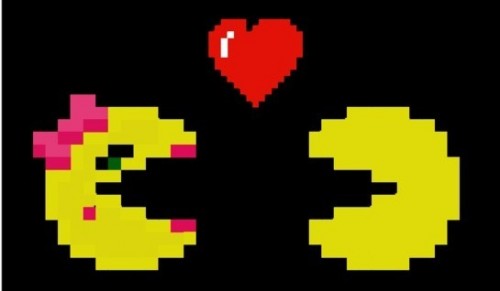Anita Sarkeesian is back with a new installment in her feminist analysis of video games. This one is a 25 minute discussion of the Ms. Male Character Trope, the phenomenon in which video games spice up their characters by including a female modeled off of the original male character. It’s a good example of the way in which males are centered, while females, if included at all, are seen as a non-normative kind of human, animal, or thing.
She starts with the classic example of Pac-Man and Mrs. Pac-Man, observing that only Mrs. is marked with symbols of femininity; Pac-Man, who’s not even called Mr. Pac-Man, has no markers at all. This is typical. This is how maleness is made simultaneously invisible and front-and-center, while femaleness is othered. Like this:
A fan sent her an example of what a reverse world would look like, where women were the default and men were marked and othered. Awesome:
Here’s the whole video:
Lisa Wade, PhD is an Associate Professor at Tulane University. She is the author of American Hookup, a book about college sexual culture; a textbook about gender; and a forthcoming introductory text: Terrible Magnificent Sociology. You can follow her on Twitter and Instagram.


Comments 24
Bill R — January 4, 2014
Here we have yet another example of focusing attention on the mirror instead of the world its reflecting.
(Brief history: Pac-Man (1980) was the first successful video arcade game that attracted female customers. The response by the producers was Ms. Pac-Man (1982) which became wildly commercially successful, and iconic to the industry.)
Midway Manufacturing--the producers--saw that the original Pac-Man game attracted a market they did not believe they had a chance with: females. From a business perspective that's incredibly exciting. So they decided to go full-bore into the female market, and Ms. Pac-Man represented their best ideas to do so. AND IT WORKED!
The real question of interest here is why the game's features were so incredibly successful in the real world. Unfortunately, while these features are uniformly criticized, they way commercial advertisements are on this board too, little effort is made to explain the underlying real-world phenomena.
Amara — January 4, 2014
Point totally taken, but it is worth noting that she wasn't MRS. Pac-Man, she was MS. As in, she wasn't automatically defined by her relationship status even though she's female. Wonder if that would happen today?
Wondering — January 4, 2014
I think the "reverse" pac-characters would have more impact as Pac-Lass and Mr Pac-Lass. I would also accept Pac-Dame and Mr Pac-Dame. Even the word woman normalizes the word man.
(And I am not someone who wants to change the spelling of "woman", I'm just pointing out the obvious.)
Mr. S — January 6, 2014
Or... it could be that once Pacman became a huge arcade success, programmers took a shortcut by recoloring the existing palette to create a "brand new" game with a "brand new" character. The fact that the graphic designers simply layered feminine symbols onto Pacman is a product of limited 8-bit graphics and Capcom trying to make an easy dollar.
It's not just a gender thing - Super Mario Bros 2 took the exact same approach with a Japanese game called Yume Kōjō: Doki Doki Panic. The game's existing characters were re-drawn as characters from Super Mario Bros to capitalize on the original game's popularity and name-recognition. I'm sure that's usually the case when these spin-offs games/characters are made.